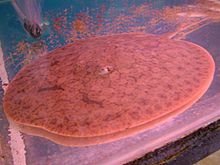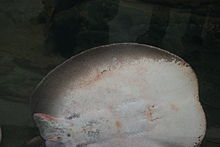Paratrygon aiereba
| Paratrygon aiereba | |
|---|---|

| |

| |
| Paratrygon aiereba from above and below. Notice its concave snout, visible lower left on upper photo and to the right on lower photo | |
| Scientific classification | |
| Domain: | Eukaryota |
| Kingdom: | Animalia |
| Phylum: | Chordata |
| Class: | Chondrichthyes |
| Subclass: | Elasmobranchii |
| Superorder: | Batoidea |
| Order: | Myliobatiformes |
| Family: | Potamotrygonidae |
| Genus: | Paratrygon |
| Species: | P. aiereba
|
| Binomial name | |
| Paratrygon aiereba (Müller & Henle, 1841)
| |
Paratrygon aiereba (also known as discus ray, manzana ray or ceja ray) is a
Appearance
This freshwater ray has small eyes and a disc shaped roughly like a
vermiculated or reticulated pattern.[3] It reaches up to 1.6 m (5.2 ft) in disc width and 110 kg (240 lb) in weight, making it one of the largest species in the family.[3] There are unconfirmed claims of much larger individuals, but these are considered highly questionable.[4] Most individuals do not surpass a disc width of 1.3 m (4.3 ft).[3]
Males reach maturity at a disc width of about 60 cm (2.0 ft) and females at about 72 cm (2.4 ft).
Behavior
It mainly feeds on fish,top predator in its habitat.[6] Adults are found in relatively deep waters in main river channels, but move to shallower waters to feed at night. After a nine-month gestation, the female give birth to an average of two young with a disc width of about 16 cm (6.3 in). Juveniles are found in relatively shallow waters at sandy beaches and in creeks.[3]
References
- . Retrieved 12 November 2021.
- S2CID 236301627.
- ^ ISBN 9780643109148.
- ^ "Paratrygon aiereba". fishing-worldrecords.com. Retrieved 25 October 2017.
- )
- )

